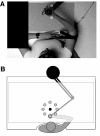Effect of trial order and error magnitude on motor learning by observing
- PMID: 20631214
- PMCID: PMC2944676
- DOI: 10.1152/jn.01047.2009
Effect of trial order and error magnitude on motor learning by observing
Abstract
Watching an actor make reaching movements in a perturbing force field provides the observer with information about how to compensate for that force field. Here we asked two questions about the nature of information provided to the observer. Is it important that the observer learn the difference between errant (curved) movements and goal (straight) movements by watching the actor progress in a relatively orderly fashion from highly curved to straight movements over a series of trials? Or is it sufficient that the observer sees only reaching errors in the force field (FF)? In the first experiment, we found that observers performed better if they observed reaches in a FF that was congruent, rather than incongruent, with the FF used in a later test. Observation-trial order had no effect on performance, suggesting that observers understood the goal in advance and perhaps learned about the force-field by observing movement curvature. Next we asked whether observers learn optimally by observing the actor's mistakes (high-error trials), if they learn by watching the actor perform with expertise in the FF (low-error trials), or if they need to see contrast between errant and goal behavior (a mixture of both high- and low-error trials). We found that observers who watched high-error trials were most affected by observation but that significant learning also occurred if observers watched only some high-error trials. This result suggests that observers learn to adapt their reaching to an unpredictable FF best when they see the actor making mistakes.
Figures





References
-
- Baldissera F, Cavallari P, Craighero L, Fadiga L. Modulation of spinal excitability during observation of hand actions in humans. Eur J Neurosci 13: 190– 194, 2001 - PubMed
-
- Bandura A, Jeffrey RW. Role of symbolic coding and rehearsal processes in observational learning. J Pers Soc Psychol 26: 122– 130, 1973
-
- Bandura A. Social Foundations of Thought and Action: A Social Cognitive Theory. Englewood Cliffs, NJ: Prentice Hall, 1986
-
- Brown LE, Wilson E, Gribble PL. Repetitive transcranial magnetic stimulation to the primary motor cortex interferes with motor learning by observing. J Cogn Neurosci 21: 1013– 1022, 2009 - PubMed
Publication types
MeSH terms
Grants and funding
LinkOut - more resources
Full Text Sources

